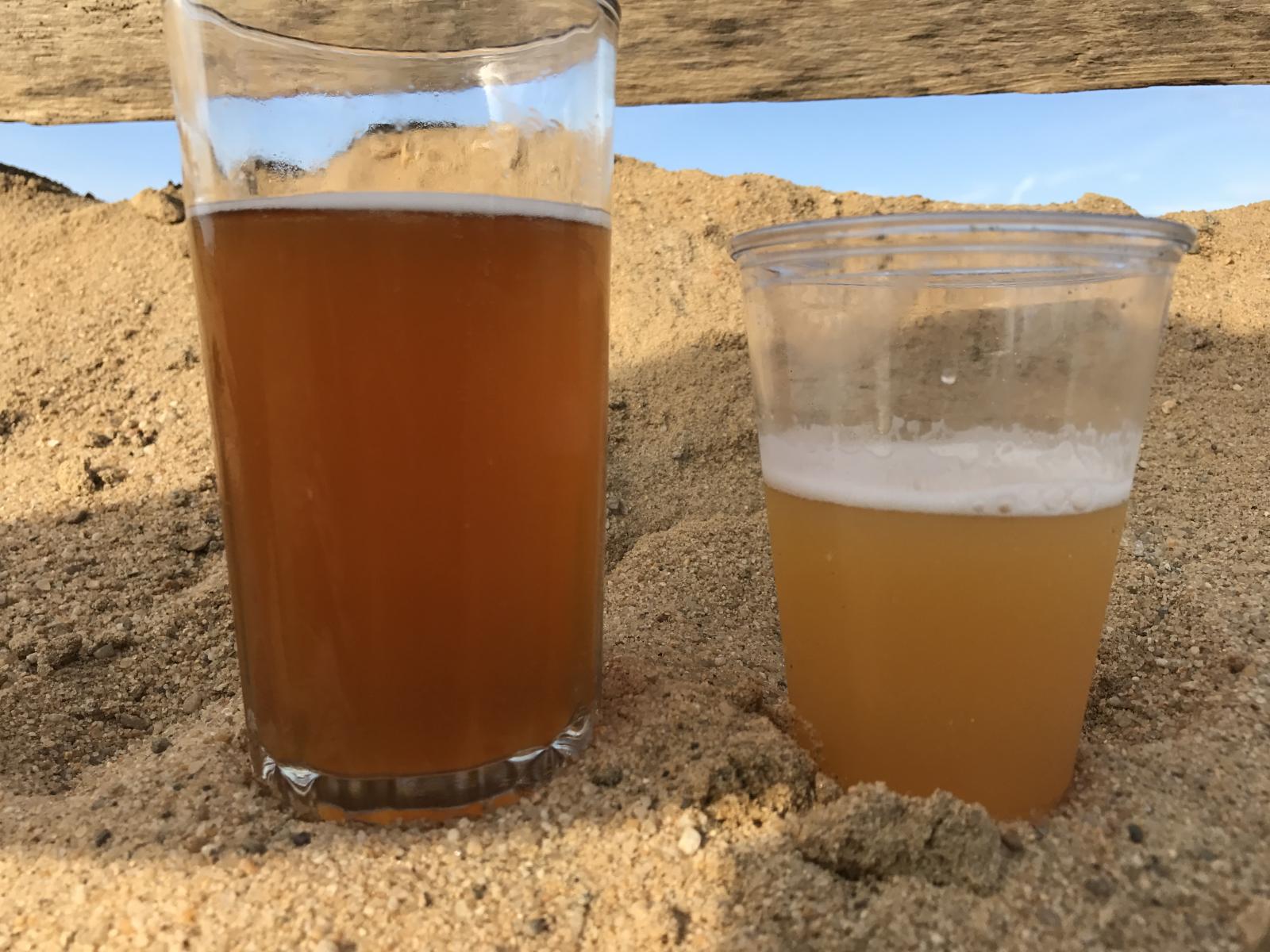Welp, it's been about 9 days since I bottled my first batch, a white IPA extract kit, so I figured I'd take a sample. See pic below.
On the right, for comparison's sake is a Trillium Congress St. IPA. World class stuff. On the left, is my "white" IPA (that doesn't look so white).
Bottom Line: Not liking what I taste.
Some good news:
* I like the color although I'm not sure this is what it should look like.
* Only 9 days out, the carbonation looks solid. Heard a nice snap upon opening.
* Very little sediment at the bottom.
The bad:
* Aroma just isn't favorable. When I take a sniff of the Trillium I get all kinds of tropical/fruity type smells. When I smell mine there's really nothing that favorable.
* Taste was overly bitter. I don't see the balance.
* Appearance: Definitely some sediment floating around in the beer. Almost looked a little too "active" as if it was maybe yeast. Keep in mind, this was the last beer I bottled so without a doubt I was getting the dregs in the bottling bucket.
So I'm thinking back to how this went and trying to identify where I can improve the process. Any help here would be appreciated. Some thoughts:
1. Bottling Conditioning: It's only been 9 days so maybe the three weeks here could improve the situation, but really how much?
2. Steeping Temp: I had trouble keeping the temperature in the right range when steeping the grains. It was up towards 180. Not sure if this is a factor.
3. Funnel Clog: When I poured the wort into the carboy the strainer in the carboy got clogged. There was some panic there. I dipped a spoon (which I sanitized) in the funnel to try and unclog. I also dumped the wort in the funnel back in the bucket and then back into the funnel minus the strainer. I remember being paranoid about sanitization here, but I could swear I did everything I could.
4. Foam: Took a while to top off my carboy due to foam. Don't really think this matters.
5. Starsan in the airlock: This was a screwup. Instead of filling my airlock halfway with starsan solution I put JUST starsan in there. I know if this seeped into the carboy it could create off flavors.
6. Blow Off Top: Once this thing cranked up it blew off in early morning hours while I was sleeping. It was probably a good 10 hours before I fully resolved the situation.
So, there it is. Really hoping another 2 weeks in the bottles helps, but I don't know. A little disappointed I must say. Gotta figure this out.
Thanks

On the right, for comparison's sake is a Trillium Congress St. IPA. World class stuff. On the left, is my "white" IPA (that doesn't look so white).
Bottom Line: Not liking what I taste.
Some good news:
* I like the color although I'm not sure this is what it should look like.
* Only 9 days out, the carbonation looks solid. Heard a nice snap upon opening.
* Very little sediment at the bottom.
The bad:
* Aroma just isn't favorable. When I take a sniff of the Trillium I get all kinds of tropical/fruity type smells. When I smell mine there's really nothing that favorable.
* Taste was overly bitter. I don't see the balance.
* Appearance: Definitely some sediment floating around in the beer. Almost looked a little too "active" as if it was maybe yeast. Keep in mind, this was the last beer I bottled so without a doubt I was getting the dregs in the bottling bucket.
So I'm thinking back to how this went and trying to identify where I can improve the process. Any help here would be appreciated. Some thoughts:
1. Bottling Conditioning: It's only been 9 days so maybe the three weeks here could improve the situation, but really how much?
2. Steeping Temp: I had trouble keeping the temperature in the right range when steeping the grains. It was up towards 180. Not sure if this is a factor.
3. Funnel Clog: When I poured the wort into the carboy the strainer in the carboy got clogged. There was some panic there. I dipped a spoon (which I sanitized) in the funnel to try and unclog. I also dumped the wort in the funnel back in the bucket and then back into the funnel minus the strainer. I remember being paranoid about sanitization here, but I could swear I did everything I could.
4. Foam: Took a while to top off my carboy due to foam. Don't really think this matters.
5. Starsan in the airlock: This was a screwup. Instead of filling my airlock halfway with starsan solution I put JUST starsan in there. I know if this seeped into the carboy it could create off flavors.
6. Blow Off Top: Once this thing cranked up it blew off in early morning hours while I was sleeping. It was probably a good 10 hours before I fully resolved the situation.
So, there it is. Really hoping another 2 weeks in the bottles helps, but I don't know. A little disappointed I must say. Gotta figure this out.
Thanks




